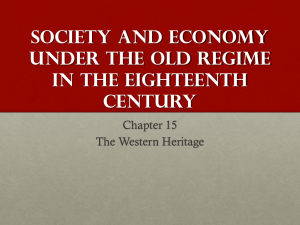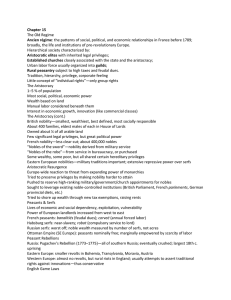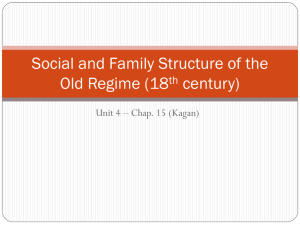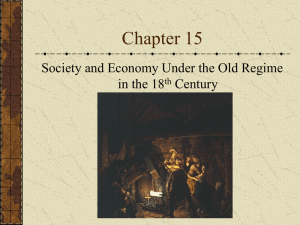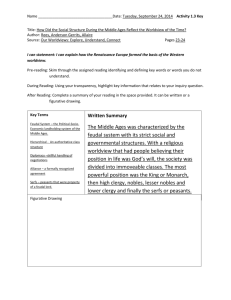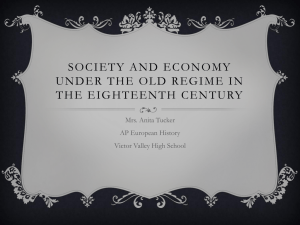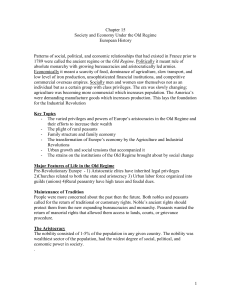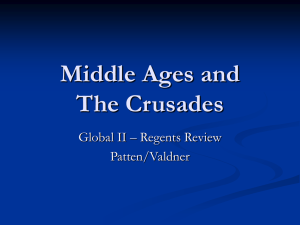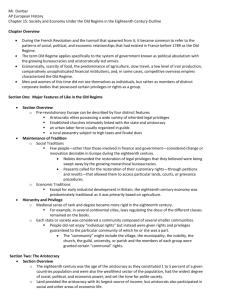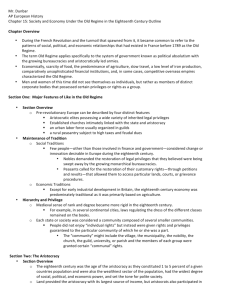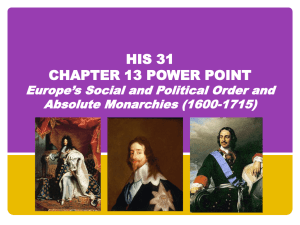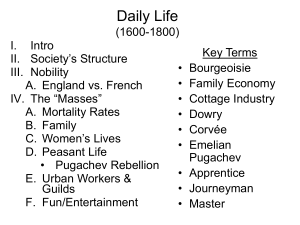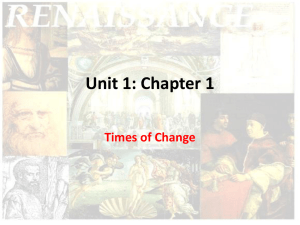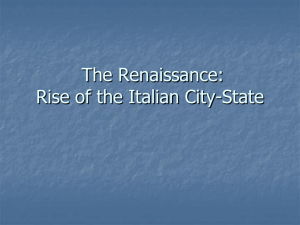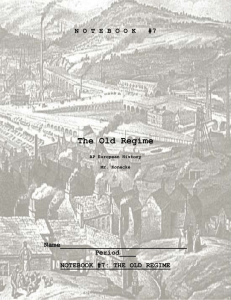Society & Economy Under The Old Regime 18th Century
advertisement
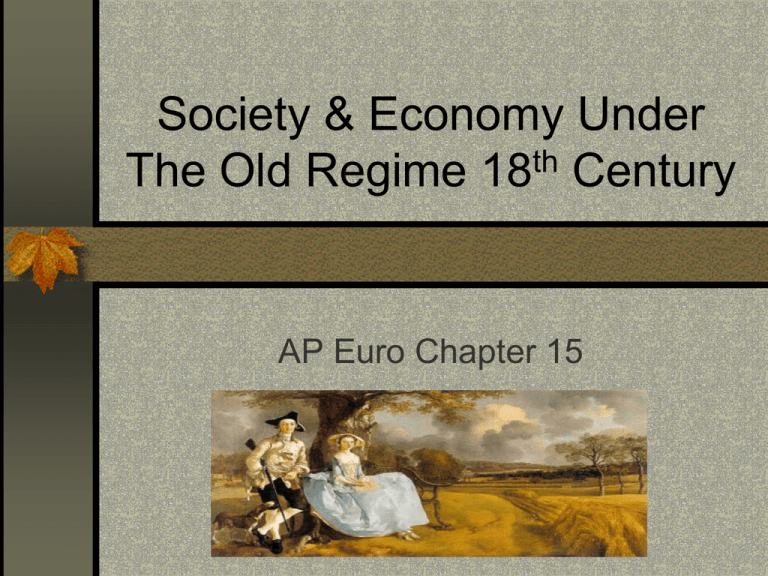
Society & Economy Under The Old Regime 18th Century AP Euro Chapter 15 Pre-Revolutionary Europe Society Prior to 1789 Is referred to the “Ancien regime”, or “old regime” Features of Old Regime 1. Aristocrats inherited privileges 2. Urban labor force organized into guilds 3.Rural peasantry subject to taxes Visible Social Hierarchy 1. Laws dictate what different classes can wear 2. Your rights depend on your social class 3. Not all have to pay taxes 4. Certain activities restricted to upper class The Aristocracy… 1. Consist of 1% to 5% of the Population in any given Euro. Country 2. Inherit wealth & Land 3. Ruling Class The Aristocracy 4. Set the example of manners & conduct 5. Lead “lives of idleness” 6. Have certain privileges British Nobility 400 elite families Average estate size: a thousand to 50 thousand acres !! Own ¼ of arable (good) farming land British Nobility Oldest son inherits title & Right to sit in House of Lords = Political power British Nobility Younger Sons Must Choose Profession: Commerce, Military Officer, Church Office. Peerage System :Titles of Nobility Amongst Aristocracy The peerage a collective term for people who possess certain titles of honor. The Titles in The Peerage ( In descending order): Duke or Duchess Marquess or Marchioness Earl or Countess Viscount or Viscountess Baron or Lady English Game Laws 1671-1831 Exclusive right of aristocrats to hunt hares, partridges, pheasants, deer etc. I am a Pheasant, not a Peasant British Noble Women "...the greatest challenge faced by females of the leisured classes was how to be leisured..." Upper class women had tutors, learned “womanly activities” and had lots of free time! 18th Century English Trends: Men Noble Men wear “Banyan” “man of the house” outfit An Asian inspired outfit for staying at home Noble Hairstyles 18th Century By 1780’s younger men wore lightly powdered natural hair 1795 English established tax for hair powder Which caused the demise of the powdered wig/hair 18th Century English Trends: Women Clothes Reflect: “softness, prettiness, delicacy” Colors reflect natural world Decorative elements 18th Century English Trends: Women & Cosmetics Pieces of leather or fabric applied with adhesive on face to hide imperfections Lead face powder Rouge made from plaster of Paris & Carmine Aristocrats In France Different From England Nobility acquired through: 1. Birth- inherited 2. office - awarded 3. “letters”- King’s order French Titles of Nobility Duke Marquis Comte (Earl) Vicomte (viscount) Baron French Aristocratic Families & Prestige how long had a given family been noble (l'ancienneté), into what other families did it marry (les alliances), what positions its members achieved and what offices they held (les dignités), what actions they performed (les illustrations) French Aristocrats 400,000 nobles Divided Into: “Nobles of the sword”-military service “Nobles of the robe”bureaucracy Second estate French Nobility Hobereaux – provincial nobility Not as wealthy But “nobles” non the less French Aristocrats Exempt from taxes Rarely had to pay vingtieme income tax in full Hunting & Fishing privileges French Aristocrats Known for extravagance in manner , dress, court culture Remember Versailles? Peasants & Serfs Rural Reality The Importance of Land Economic basis 18th cent. Europe Foundation of status & power for nobility Source of oppression for peasants Rural Reality 3/4ths of all Europeans live in rural areas Work the land Peasants & Serfs: What’s the Difference? Peasants – are “free” tenants (Western Europe) Serfs- are not free. More like slaves (Eastern Europe) French Peasants Seigneur or Land Lord can: Require labor from peasants Charge feudal dues Russian Serfs Nobles wealth measured by serfs, not land acreage Barshchina- 6 day work week Serfs can be punished Like slaves Russian Serf Rebellions Over 50 in 1762 Pugachev’s Rebellion in Southern Russia (1773-1775 ) Emelyan Pugachev Promises: Serfs land of their own Freedom from landlord Russian govt. crushes rebellion The Family Economy & The Household Rural Living Pre-Industrial / PreRevolution The Household… Basic unit of production also known as “The Family Economy” 2 models: 1. North Western Europe 2. Eastern Europe 1. North Western Household Household consists of the Nuclear Family: Married couple, children , maybe a servant (younger person, a social equal, works until marriage). Children live with parents until teen years 1.North Western Household Neocalism- when child moves away from home Men marry at 26 Women marry at 23 Considered “late” marriage 2. Eastern Europe Household Household consists of Extended Family: Married couple, children, grandparents etc. Larger households Younger Parents Idea is to “add” to household, not leave Family Economy 1. Impossible for ordinary people to support themselves independently 2. Everyone in household works 3. Goods produced for benefit of household 4. “self contained” unit Those Who Lived By Themselves… seen as suspicious! Potential criminals, or beggars Remember, even servants lived with a family… Women and the Family Economy Marriage regardless of class, an economic necessity! Number 1 concern: maintaining house Number 2 concern : bearing and rearing children Life of Lower Class Women At age 7, girls considered old enough to help around the house Once a girl left home, she had to support family, and save up for her dowry Women & Children High mortality rates for children – disease Unsanitary conditions The poor could not afford babies Foundling Hospitals Paris, London Homes for abandoned children “orphans” Most children illegitimate Parents could not afford them/gave them up Abandoned Children Link between movement of people and an increase in abandoned children Link between rise of food prices and abandoned children The Sad Truth… Only 10 % of abandoned children lived to the age of ten. The Agricultural Revolution Changes in the midst… Developments That Transform European society & economy Agricultural Questions 18th Century 1. How do you produce surplus crops? 2. How can you bring down the price of crops? Agricultural Revolution Innovations in agriculture led to improvements in agricultural production And Transformed the “traditional” family economy Jethro Tull (1674-1741) English Developed Seed Drill Seed drill Allows seeds to be planted in rows, rather than by casting seeds randomly Charles “Turnip” Townsend (1674-1738) English; Introduced Crop Rotation – wheat, turnips, barley, clover Crop rotation Restores nutrients in soil Robert Bakewell (1725-1795) English; Pioneered new methods of animal breeding Bred stronger animals Enclosure System 1. The fencing off of common lands 2. Commercialized agriculture (no longer a communal ritual) Improvements in agriculture 1. Impacted the food supply in a positive manner 2. Allow landowners to have a “disposable” income – money left over to purchase manufactured goods, or invest in other business opportunities Demographic Changes Europe’s Population Rose 1700 – 100 and 120 million By 1800 – 190 million By 1850 – 260 million Mortality rates declined due to Changes in food supply Industrial Revolution Mid – Late 1700’s From Domestic System to Industrialization Industrialization Second Half of 18th Century Focus on “Manufactured goods” 1. Led to movement of people 2. Growth of cities 3. Industrialization Industrial Revolution Begins in Great Britain… Why? 1. Economic Center 2. Print Media : Newspapers, Magazines, advertising 3. Good roads & waterways to transport goods 4. Stable banking system 5. Mobile society & Large Population 6. Rich deposits of coal & ore 7. Transformation of Textile Industry “Domestic” System (“Putting Out System) 1. Peasant home #1 would spin thread at home for extra $. 2. Agent would take finished thread to peasant home #2 . This family would then weave thread into fabric. Domestic System of Textile Production Was basic feature of family economy until Mid 18th Century The demand for cotton textiles grew more rapidly than production, So … Investors searched for faster ways to produce fabric & clothing 1. Water Power 1700’s Water Wheels power first machines & factories Thus, 1st factories had to be built by water source 2.The Flying Shuttle (1730’s) Invented by: John Kay Allowed weavers to work fast Problem: they outpaced spinners 3.The Spinning Jenny (1764) Invented by : James Hargreaves Spun many threads at the same time (16 originally) 4. Water Frame (1769) Invented By: Richard Arkwright Used water power to speed up spinning 5. The Steam Engine 1. Thomas Newcomen’s original invention 1712 – large, inefficient Used to pump water out of coal mines 5. The Steam Engine 2. James Watt’s Modified Version 1769 – revolutionized industry Use of steam engine spread slowly until 1800’s 6. Power Loom (1780’s) Invented by: Edmund Cartwright Did not gain importance until 1830’s! By then, more power loom weavers than hand loom weavers Growth of Cities Population Growth between 1500-1800 However, less than 20% of population lived in cities (in France, and in Great Britain) Growth of Capitals & Ports (1600-1750) 1. Growth of Ports – a reflection of expansion of overseas trade 2. Growth of Capitals – a reflection of the success of monarchical state New Cities Emerge, Small Cities Grow (mid 18th cent) 1. Innovations in agriculture – improved crop production led to growth of market towns 2. Factories Near Water – towns “grew” around factory as People moved. Social Divisions differences between rich & poor Nobles : Attempt to secure & expand privileges. Live “beautiful” lives Poverty: found in both cities, & countryside. Live “filthy” lives. Lower classes have no rights, no chance at social mobility. The Middle Class or “Bourgeoisie” Urban residents Merchants, trades people, bankers, Lawyers, Professionals Grow wealthier and wealthier Want political power and Social Prestige Inequality of the Social Classes Leads us to… The French Revolution 1789-1800 To be continued…
